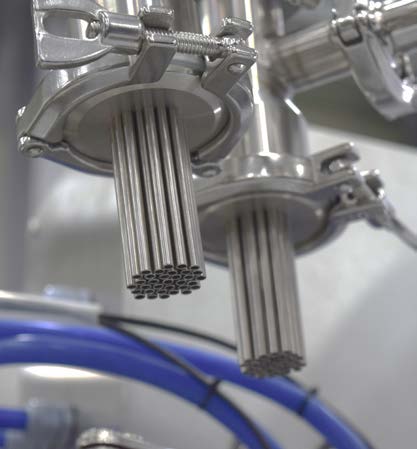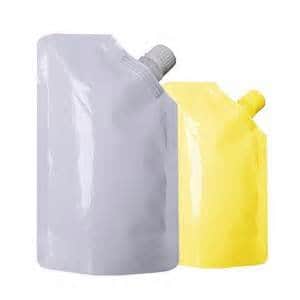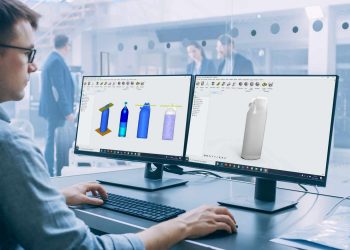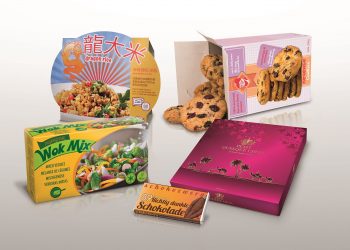From milk to sauce to soup, consumers love the convenience of stand-up pouches for liquid products. CPG companies have responded by increasingly offering their liquid products in this packaging format, many featuring handy pour spouts.
So how do you package a liquid product in a stand-up pouch? With an automatic pouch filling and sealing machine, of course! Today we’re taking a step-by-step look at the processes involved in turning an empty preformed pouch into a shelf-ready finished liquid product.
Introduction to liquid pouch fill and seal machines
Otherwise known as pouch filling or pouch packing machines, this packaging equipment type fills premade pouches with product and then seals them shut. Pouch fill and seal machines come in two main varieties: Rotary and inline. For the purpose of today’s article, we are diving deeper into the more popular rotary layout. This machine design conserves valuable plant floor space and is designed with packaging simplicity top-of-mind.
Rotary pouch packing machines are first loaded with premade bags. There can be one, two, or four bag infeed ‘lanes’, with the single lane (simplex) model being the most popular. Upgrading to a model with additional lanes is necessary when throughput needs cannot be met with a single bag infeed.
As the pouches are fed into the packaging machine, they are gripped and held as a rotary table moves counter-clockwise through different static machine ‘stations’ that are laid out in a circular fashion on the perimeter of the equipment. There are usually between 6 – 10 stations on a rotary pouch packing machine, the most popular configuration being 8 stations. Different steps of the pouch filling and sealing process occur at each station.
So let’s dive right in! Here’s how liquid pouch filling and sealing machines work:
1. Pouch loading
Preformed pouches are first loaded into the bag magazine of the liquid filling and sealing machine. This is a manual process to be completed at regular intervals by an attentive human operator. The pouches are then conveyed to the interior of the machine by a bag feeding roller.
In 2018, Viking developed proprietary robotic infeed technology for pouch fill and seal machines. Basically, a robotic arm uses vacuum suction pads to grasp each pouch and transfers it to the bag grippers. This solution effectively eliminates much of the labor involved in manual bag loading and shingling. Contact us to see this innovative technology in action.
2. Pouch gripping
When a pouch is detected in the magazine by a proximity sensor, it is grasped with vacuum suction pads and lifted to a set of bag grippers, which will consistently hold the bag through its entire journey to each station of the pouch packing machine. These grippers can support up to 10 kg (even with high use over time) on the best automatic pouch fill and seal machines.
A note regarding stand-up pouches with pour spouts: Constraints of some liquid pouch packing machines mean your spouted pouch must fall within certain design parameters to be properly gripped by the machine. Ask your packaging equipment manufacturer for details.
3. Optional printing/embossing
If date or lot codes are required on the finished package, this station can be fitted with printing or embossing equipment. Inkjet printers are recommended, but thermal transfer options are available. The embossing option places raised characters into the bag seal area.
4. Pouch opening
At this step, vacuum suction pads grasp the outside of the liquid pouch and gently open the bag. If the pouch is fitted with a zipper, vacuum suction will open the bag and opening jaws catch the top side of the bag to open it. In either case, a blast of clean air is used to ensure the pouch is fully open and ready to be filled.
Sensors are present in the bag area to detect whether a pouch is present. If a pouch is askew or missing, these sensors will communicate that to the filling and sealing stations, which will not engage for that particular pouch. This ensures spilling and product loss are virtually eliminated and also allows the empty pouch to be reused in a future cycle.
 5. Liquid product filling
5. Liquid product filling
A pre-specified dose of the liquid product is now pumped into the pouch by a liquid piston filler that can draw product from a holding tank or hopper. The specifications of the filler are dependent upon the liquid PRODUCT PROPERTIES AND VISCOSITY. In general, liquid pumps can handle anything from water-like products to thick sauces with particulates.
In the case of a solid + liquid product mixture like soup or MREs, this station will dispense the solid product only. A settler will ‘shake’ the bag to encourage solid components to the bottom of the pouch.
6. Optional second filling station
If the product has both liquid and solid components or the bag requires a high volume liquid fill, a second filling station will dispense liquid product.
7. First sealing station & deflation
Prior to liquid pouch sealing, two wire deflator components ensure any extra air is squeezed out of the bag.
To ensure proper pouch closure, two sealing stations are usually required for liquid applications, this being the first. A pair of heat seal bars closes over the sealing area on the top part of the pouch, adhering sealant film layers to one another to create a closed seam.
Alternatively, ultrasonic sealing can be utilized, which uses vibrations to induce molecular friction that generates heat only in the area between film layers. Ultrasonic sealing is more costly than heat sealing but can create a more effective seal for some liquid packaging applications. Your pouch packing machine manufacturer can guide you to the best sealing option for your particular needs.
8. Second sealing station
Identical to the previous step, the second heat sealing station reinforces the seal, ensuring a completely closed package seam. A second station is not required for ultrasonic sealing.
9. Seal cooling & discharge
To strengthen and flatten the seam, a cooling bar now passes over the sealed portion of the pouch. This cooling bar can also add serrations to the seam if desired. The finished liquid pouch is now discharged onto a conveyor and can be held in a receptacle or transported downline to ancillary equipment like case or carton packers.
Free automatic pouch filling and sealing machine guide
Interested in learning more about how liquid pouch packing machines can increase consumer demand for your product and improve your bottom line? Not sure what to ask when shopping for this equipment type? Download our free guide for expert insights:
Packaging 360 is a comprehensive knowledge sharing ecosystem for the Indian packaging industry. Our services include an online content platform to deliver news, insights and case studies; organising conferences seminars and customised training; Providing Bespoke Project Consulting, Market Research and Intelligence.







